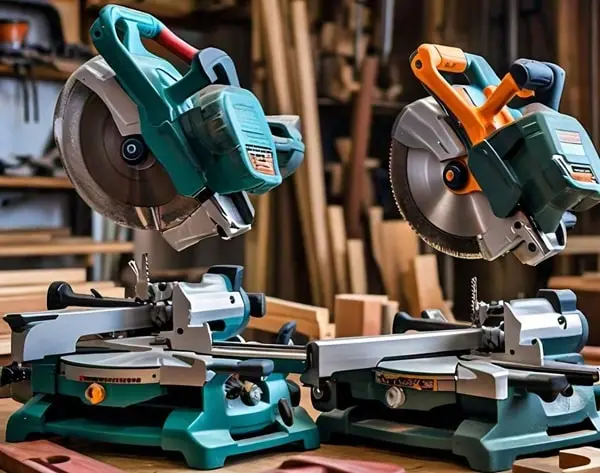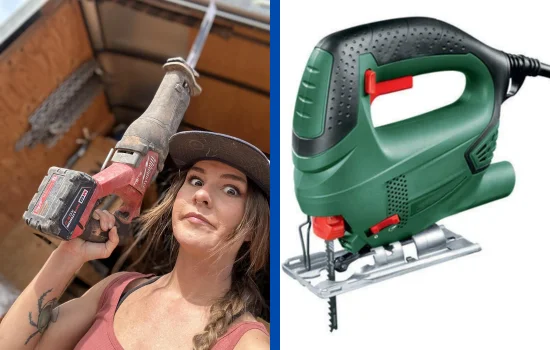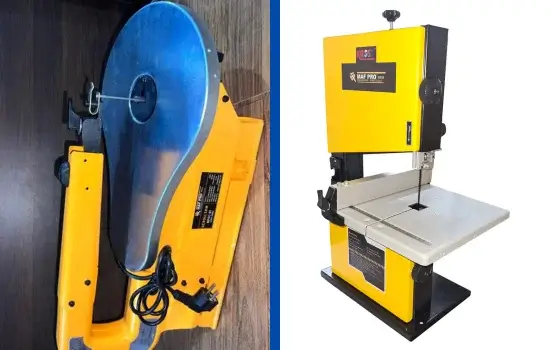When it comes to making precise angled cuts in woodworking or carpentry, the miter saw is an indispensable tool. Two popular types of miter saws that often come up in discussions are the single bevel and double bevel miter saws. Both are capable of making angled cuts, but each has distinct features that make it more suitable for specific applications. Understanding the differences between these two types can help you select the right saw for your needs, whether you’re working on crown molding, furniture, or framing.
In this article, we’ll provide a thorough comparison of single bevel and double bevel miter saws, covering their features, advantages, limitations, and ideal uses.
Definitions of Single Bevel and Double Bevel Miter Saws
Single Bevel Miter Saw
A single bevel miter saw can tilt in only one direction, typically to the left. This tilt enables the saw to make bevel cuts on one side of the material. However, if you need to make a bevel cut on the opposite side, you must manually flip the material to achieve the angle. Single bevel miter saws are often used for simpler woodworking tasks where bevel cuts are needed but not at both angles.
Double Bevel Miter Saw
A double bevel miter saw, sometimes called a dual bevel miter saw, has a blade that tilts both left and right, allowing it to make bevel cuts in either direction without having to reposition the material. This feature is especially useful for projects that require a series of identical cuts on both sides of the workpiece, such as crown molding and other trim work.
Key Differences Between Single Bevel and Double Bevel Miter Saws
| Feature | Single Bevel Miter Saw | Double Bevel Miter Saw |
|---|---|---|
| Bevel Range | Tilts in one direction only | Tilts in both left and right directions |
| Efficiency | Requires flipping the material for opposite bevels | No need to flip material for opposite bevels |
| Cutting Precision | High for basic bevel cuts | High for compound and repeatable bevel cuts |
| Applications | Basic woodworking, framing, DIY projects | Crown molding, trim work, complex carpentry |
| Ease of Use | Simple to use, but requires manual adjustment | Easier for repetitive cuts and complex angles |
| Portability | Often lighter and more portable | Generally larger and heavier |
| Cost | More affordable | More expensive |
Detailed Comparison of Single Bevel and Double Bevel Miter Saws
1. Bevel Range and Cutting Capabilities
- Single Bevel Miter Saw: A single bevel miter saw tilts in only one direction, usually to the left. This allows for accurate bevel cuts in one direction, but if you need to make a matching bevel cut on the opposite side of the material, you’ll need to manually flip the material over. While this is manageable, it can be time-consuming, especially if you need a series of mirrored cuts. However, single bevel miter saws are effective for simple projects that don’t require bevel cuts on both sides of the material.
- Double Bevel Miter Saw: Double bevel miter saws tilt in both directions, meaning the blade can pivot left or right. This design enables you to make bevel cuts on both sides of the material without having to reposition it. For complex projects that involve a lot of repetitive or mirrored cuts, like crown molding or trim work, a double bevel saw is more efficient and reduces the margin for error. This versatility makes double bevel miter saws ideal for professional woodworkers and contractors who often work with detailed and intricate angles.
2. Efficiency and Workflow
- Single Bevel Miter Saw: With a single bevel miter saw, making opposite bevel cuts requires additional steps, as you must flip the workpiece manually. This can interrupt workflow, particularly for projects that require repetitive or mirrored cuts. While this process is straightforward for occasional use, it can be cumbersome for complex projects, making single bevel miter saws more suitable for simpler woodworking tasks.
- Double Bevel Miter Saw: Double bevel miter saws eliminate the need to flip the material, allowing you to achieve mirrored bevel cuts by simply adjusting the angle of the blade. This streamlined process saves time and effort, making double bevel miter saws more efficient for complex, high-volume projects. With a double bevel saw, you can focus on making accurate cuts without worrying about repositioning the material, which can reduce potential mistakes.
3. Cutting Precision and Versatility
- Single Bevel Miter Saw: Single bevel miter saws offer excellent precision for standard miter and bevel cuts, but they are limited when it comes to making compound cuts (miter and bevel cuts combined) on both sides of the material. The need to flip the material manually introduces a chance for slight misalignment, especially if the material is large or difficult to handle. For simple angle cuts, however, a single bevel saw provides more than enough accuracy and control.
- Double Bevel Miter Saw: Double bevel miter saws provide greater versatility and accuracy for projects that require compound cuts. They allow for precise angle adjustments on both sides of the workpiece, ensuring that cuts are consistent and symmetrical. This precision is particularly valuable for trim work, framing, and complex projects where mirrored cuts are needed, as it reduces the risk of misalignment.
4. Applications and Ideal Uses
- Single Bevel Miter Saw: Single bevel miter saws are ideal for basic woodworking, framing, and general carpentry. They work well for projects that don’t require bevel cuts on both sides of the material, making them suitable for DIY projects, home repairs, and smaller jobs. They are perfect for simple trim work, framing lumber, and small carpentry tasks that involve straightforward angle cuts.
- Double Bevel Miter Saw: Double bevel miter saws are more versatile and are ideal for complex projects like crown molding, baseboards, cabinetry, and any project that involves intricate angles or compound cuts. Professionals and experienced woodworkers often prefer double bevel miter saws for their efficiency and ability to handle repetitive cuts without repositioning the material, making them a better choice for high-volume or precision tasks.
5. Ease of Use
- Single Bevel Miter Saw: Single bevel miter saws are relatively easy to use, especially for beginners. They have a simpler design with fewer adjustments, making them straightforward for users who need basic angle cuts. However, the need to flip the material when making opposite bevels can be challenging for new users, especially when working with large or heavy pieces.
- Double Bevel Miter Saw: Double bevel miter saws are generally easier to use for projects that involve repeated bevel cuts, as they allow users to adjust the blade angle without flipping the material. This design is more user-friendly for professionals who require efficiency and consistency in their cuts. However, double bevel miter saws can be more complex, with additional controls and adjustments that may require some experience to master.
6. Portability and Workspace Requirements
- Single Bevel Miter Saw: Single bevel miter saws are typically smaller, lighter, and easier to move, making them more portable and convenient for contractors or DIY enthusiasts who need to transport the saw to different locations. Their compact size also makes them suitable for small workshops or garages with limited space.
- Double Bevel Miter Saw: Double bevel miter saws are generally larger and heavier due to the additional tilt and pivot mechanisms. This added weight makes them less portable and better suited for stationary setups in a workshop. While there are portable options, double bevel miter saws typically require more space, making them a better choice for professionals who work in a fixed location.
7. Cost Considerations
- Single Bevel Miter Saw: Single bevel miter saws are generally more affordable than double bevel models, making them an attractive option for budget-conscious users or beginners who don’t need advanced features. They offer excellent value for basic woodworking tasks and are available at various price points, with entry-level options suitable for occasional use.
- Double Bevel Miter Saw: Double bevel miter saws are more expensive due to their added features and versatility. The ability to make bevel cuts on both sides adds to the cost, making double bevel miter saws a more significant investment. However, for professionals and serious woodworkers, the efficiency, precision, and time saved often justify the higher price.
Pros and Cons of Single Bevel and Double Bevel Miter Saws
Single Bevel Miter Saw Pros:
- Affordable and budget-friendly
- Simple design, easy to use for beginners
- Lightweight and more portable
- Ideal for basic angle cuts and simple projects
Single Bevel Miter Saw Cons:
- Limited to bevel cuts in one direction
- Requires flipping material for opposite bevels, which can be time-consuming
- Less efficient for projects with repetitive or mirrored cuts
Double Bevel Miter Saw Pros:
- Can make bevel cuts in both directions without flipping the material
- Highly efficient for complex projects, like crown molding and cabinetry
- Precise for compound cuts and mirrored angles
- Ideal for high-volume and professional work
Double Bevel Miter Saw Cons:
- More expensive than single bevel miter saws
- Heavier and less portable, requiring more space
- May be more complex for beginners due to additional adjustments
Choosing Between a Single Bevel and Double Bevel Miter Saw
When deciding between a single bevel and a double bevel miter saw, consider your specific needs, budget, and experience level:
- If you’re working on basic carpentry projects, framing, or simple woodworking tasks, a single bevel miter saw is likely sufficient. It’s affordable, easy to use, and provides accurate angle cuts, making it ideal for DIYers and beginners. For jobs that don’t require frequent mirrored or compound cuts, a single bevel saw is a cost-effective option.
- If you’re a professional woodworker, contractor, or are working on complex projects that require detailed cuts on both sides of the material, a double bevel miter saw is the better choice. It saves time and reduces errors by allowing you to make bevel cuts on both sides without repositioning the material. Although it’s a bigger investment, the double bevel miter saw’s versatility and efficiency make it worthwhile for high-volume or precision work.
Many woodworkers and contractors find that having both types of miter saws can be advantageous, as each offers unique benefits for specific tasks. However, for most users, choosing the right miter saw based on project requirements, budget, and experience will provide the best results.
Conclusion
Both single bevel and double bevel miter saws are powerful tools that bring unique strengths to the woodworking workshop. While single bevel saws are affordable and ideal for basic projects, double bevel saws provide advanced capabilities for complex tasks, ensuring efficient and accurate cuts. By understanding the differences between these two types of miter saws, you can make an informed decision and select the tool that best meets your needs and enhances your workflow.


